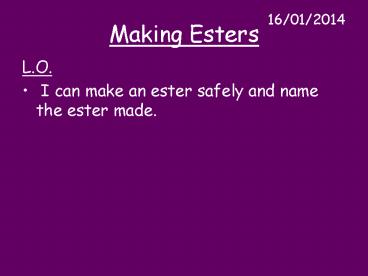Making Esters PowerPoint PPT Presentation
1 / 12
Title: Making Esters
1
Making Esters
16/01/2014
- L.O.
- I can make an ester safely and name the ester
made.
2
Making Esters - Esterification
- To make a perfume a chemical called an ester is
- made. An alcohol mixed with an acid makes an
ester. - Alcohol Acid Ester Water
- This reaction is reversible (it goes both ways).
Alcohol Acid Ester
ethanol
propanoic
ethyl propanoate
butanol
butyl ethanoate
ethanoic
propyl butanoate
butanoic
propanol
methanol
ethanoic
methyl ethanoate
3
Making esters - Practical
- Setting up the Equipment Step 1
- In the reaction vessel containing anti-bump
granules add with care- - 1cm depth of ethanol
- 1cm depth of glacial ethanoic acid
- ONLY 2-3 drops of conc. sulphuric acid
- (add 1 microspatula of anti-bumping granules if
not already in there)
4
Making Esters - Practical
- Setting up the Equipment Next steps
- 2. Screw the reaction vessel firmly onto the
combostill head. - 3. Screw the heating vessel firmly onto the
combostill head (it should be filled to a level ¼
below the top with silicone oil and a few
antibumping granules). - 4. Slide onto the ring stand and fit into well F1
of the comboplate.
5
Making Esters - Practical
- Setting up the Equipment Next steps
- 5. Push the reflux column into the combostill.
- 6. Push the thermometer into the side of the
combostill head. (see diagram). - You have now successfully set up the equipment
- (check that your equipment looks like the
diagram).
6
Making Esters - Refluxing
- Refluxing
- 1. Light the microburner and place in the
comboplate in well F4 under the heating vessel.
(As the silicone oil is heated, one should see
the heat currents flow in this vessel). - 2. Once the contents of the reaction vessel begin
to boil, remove the direct heat by placing the
microburner into well F5. - 3. Reflux for a short period of time (3-5 mins).
7
Making Esters - Distilling
- Distilling
- 1. Remove the heat source completely and allow
the system to cool down for 5 mins. Complete
worksheet. - 2. Remove the reflux column.
- 3. Remove the mineral wool from the distillation
column and attach to combostill (put mineral wool
in A1).
8
Making Esters - Distilling
- Distilling
- 4. Heat until the reaction mixture boils
(76-770C) and collect the distillate in a small
labelled test tube. Note the distinctive smell of
the ester.
9
Comparing Esters
- Compare the smell of your ester with those made
- by the other groups.
10
Testing Cosmetics
- Cosmetics need to be _______________ tested so
that they do not harm humans. - They must not cause rashes or __________.
- They must not cause skin damage or lead to
___________ or other life threatening conditions
in long-term use. - Testing takes many _______.
thoroughly
itchiness
cancer
years
11
Testing Cosmetics - continued
- Some people object to ______________ being
- tested on animals as the animals may be
- ________. The animals have no _________
- over what happens to them. These people say
- that there are other ways of testing products
- that are less _________ to living things.
cosmetics
control
harmed
damaging
12
Testing Cosmetics
- Other people ay they feel ________ if
- the cosmetics have been tested on
- __________. They say that an animals
- ___________ to a chemical closely
- mimics the reaction in a ________. If
- there is no _________to the animal then
- it is likely that the cosmetic or
- ___________ will be safe for use by
- people.
safer
animals
reaction
human
danger
perfume
13
Volatility
- We can smell an ester because particles leave the
ester, diffuse through the air and stimulate
sensors in our nose. - The volatility (ease of evaporation) of perfumes
(esters) can be explained using ideas about
moving particles.
Movement of particles
DIFFUSION
low concentration
high concentration
14
Explaining the results
- Water does not dissolve nail varnish. This is
- because the force of attraction between two water
molecules is stronger than that between a water
molecule and a molecule of nail varnish.
Weak forces of attraction between water molecule
and nail varnish molecule.
Strong forces of attraction between nail varnish
molecules.
Strong forces of attraction between water
molecules.

